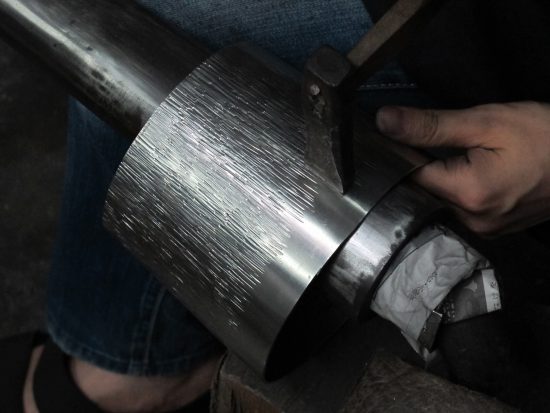Production of pewter products, mainly tableware, became popular along with the development of civilization as early as around 2500 B.C. Pewter products are typically made of pewter alloys more than 90% of which is composed of tin, although production processes and material compositions slightly differ depending on the region and the period.
The traditional pewter ware rarely uses purely tin (more than 99%) base metal, since pure tin is too soft and containers made of pure tin have an extremely short life span. Therefore, other metals are always added to form an alloy to make it hard and durable. (Many metals, not only pewter, undergo a structural failure called “fatigue” when a load is applied. Keeping them stationary is important for preventing failure.)
Pewter alloys (also called Britannia metal) used worldwide consist of 91% tin, 7-8% antimony, and 2% copper. They have characteristics of being hard and easy to process, but also has a drawback of being likely to discolor. In contrast, the modern Japanese pewter ware contains a high percentage of tin (more than 97%), and therefore it is less prone to discoloration. It has a beautiful color, but it is softer and more susceptible to damage than other pewter alloys.
Seikado uses different base metals with several different compositions for different types of tableware. Among them, a special alloy consisting of 99% tin and 1% silver is used for products that involve hammering of pewter sheets. This alloy is purposely employed since it retains a relatively beautiful, clean-looking color after a few decades of use, and is easy to process, having moderate hardness and ductility. For cast products, less than 1% of bismuth and antimony are sometimes added to improve castability.
Tin is essentially harmless to the human body, but other metals that are mixed with it must be harmless as well, since the products come in contact with food. It’s true that some of the ancient pewter products contained toxic materials such as lead, cadmium, etc., but today, the materials used in food and beverage vessels are strictly regulated by Food Sanitation Act. Some people have a misconception that pewter products are harmful to the body, but we suspect that they mistake pewter for lead, which has similar characteristics, or perhaps it is mistakenly thought to bepewter products from an older period that contained lead.
About the Naming of the Material
The metal material, expressed with the element symbol, Sn, is called by various names in different regions, such as Tin, Étain, and Zinn. In this article, the designation of “Pewter” is consistently used on purpose, since tin products and the materials used for those products are generally referred to as pewter. However, as mentioned in the article, for pewter products, not pure tin (the element symbol, Sn), but alloys of tin mixed with other metals are used.

Related Guides
About purchasing
We have an online store in addition to our physical store Teramachi-Nijo in Kyoto.


